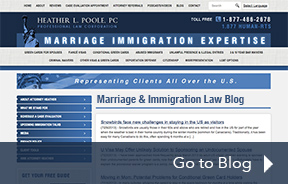Work-based Green Cards
Current U.S. immigration law allows people who have skills and talents needed in the United States to be admitted to the United States to work on a temporary or permanent basis. Immigrant (Permanent Resident) Visas for Business
There are five basic types of business immigrant visas, ranked in order of priority of need by U.S. employers and the economy, as determined by Congress. All categories are limited by annual levels and per-country levels.
These immigrants become permanent residents— obtain “green cards” — and the indefinite right to live and work in the United States, as long as they do not commit any offense that would render them deportable.
Business immigrants usually are sponsored by a U.S. employer based on a demonstrated need.Some business immigrants may self-petition if they meet statutory criteria for “extraordinary ability” in their field, or if their entry would be in the “national interest.”
Protections for U.S. workers are built into the system. Most business immigrant cases require Department of Labor certification that no U.S. workers are able, qualified or willing to take the position offered to the foreign national and that admitting the immigrant won’t negatively impact the wages and working conditions of similarly situated U.S. workers. The only categories exempt from this requirement are those for individuals who are extraordinary or outstanding in their field or whose presence is in the “national interest.”
Employment or Work-Based Sponsorship
THE EMPLOYMENT PREFERENCE SYSTEM allows certain immigrants to obtain permanent residence (“green cards”) in the United States to work. Currently, immigration law allots 140,000 employment-based visas to immigrants. These employment-based visas are divided into the following categories:
FIRST PREFERENCE:
Up to 40,000 visas a year may be issued to priority workers. People who have “extraordinary ability,” “outstanding professors and researchers,” and “certain multinational executives and managers” fall into this category. In addition, any visas left over from the fourth and fifth preferences (see below) are added to this category.
SECOND PREFERENCE:
Up to 40,000 visas a year (plus any visas left over from the first preference) may be issued to persons who are “members of the professions holding advanced degrees or aliens of exceptional ability” in their field.
THIRD PREFERENCE:
Up to 40,000 visas a year (plus any visas left over from the first and second preferences) may be issued to skilled workers, professionals, and other workers. The other workers category covers workers who are “capable of performing unskilled labor,” and who are not temporary or seasonal. Workers in this category are limited to 5,000 visas per year. Skilled workers must be capable of performing skilled labor requiring at least two years training or experience.
FOURTH PREFERENCE:
Up to 10,000 visas a year may be issued to certain special immigrants, including ministers, religious workers, former U.S. government employees and others.
FIFTH PREFERENCE:
Up to 10,000 visas a year may be issued to persons who have between $500,000 and $3 million to invest in a job-creating enterprise in the U.S. At least 10 U.S. workers must be employed by each investor. The amount of investment needed can vary depending on which area of the country will benefit from the investment. If the investor fails to meet the conditions specified, he or she can lose permanent resident status.
I am an employer. How can I sponsor my workers who are undocumented (entered the U.S. without a valid visa or unlawfully stayed in the U.S. on an expired visa)?
An individual worker will not be able to obtain a green card through employer sponsorship without having to leave the US and process the case at a consulate abroad if s/he (1) entered the U.S. without permission; or (2) entered lawfully but then overstayed the allowed time granted and is now out of valid immigration status; or (3) worked in the U.S. illegally (without permission from CIS), unless the person is an immediate relative of a U.S. citizen.
The problem that many workers who must leave the U.S. to pick up a green card at a consulate abroad because of past illegal status now face is the bars of re-entry. If a worker has been in the U.S. for 6 months or more without a valid visa and then leaves the U.S. (even to go to a consulate interview), s/he will not be allowed to re-enter the U.S. for three years. If a worker has been in the U.S. for 1 year or longer without a valid visa and then leaves the U.S. (even to go to a consulate interview), s/he will not be allowed to re-enter the U.S. for ten years, despite sponsorship by an employer !. Thus, it is very dangerous for an undocumented worker (i.e., “illegal alien”) to leave the U.S.
Exception : Amnesty and 245(i)
Section 245 (i), which was available until April 30, 2001, allowed any person who entered the U.S. illegally or who had overstayed a visa and was now out of status, to apply for a green card without having to leave the U.S., despite being unlawfully present, if the noncitizen had a family member or employer willing to sponsor him or her for an immigrant visa and filed this application before the April 30, 2001 deadline.
Grandfathering under 245(i). Even though 245(i) is expired and no longer available to allow adjustment for those unlawfully present, some noncitizens may still be able to take advantage of this law and not have to leave the U.S. to consular process, if an immigrant visa case was filed for them before the deadline but the person now wishes to file a different immigrant visa case (i.e., a new employer wishes to sponsor the worker) due to changed circumstances (i.e., a new employer or new marriage). The original case had to be “approval when filed” in order for you to use a new case to take advantage of the expired 245 (i) amnesty-type provision.
This is a legal standard that is best explained by an immigration lawyer, who can better determine if you would be able to file a new case and take advantage of grandfathering.
How long does it take to obtain a green card through standard employment sponsorship (labor certification)?
This process was recently revised by the Department of Labor’s PERM regulations. Now, the entire process can take potentially a year or less, depending on CIS processing times. The difficulty of the case, depending on the job title/description and the qualifications of the worker, can make any case take potentially longer.
Some of the above information was provided courtesy of the American Immigration Lawyers Association, of which Attorney Heather L. Poole is an active member and current Executive Board Member AILA’s Southern California Chapter. For more information on AILA, go to www.aila.org.






